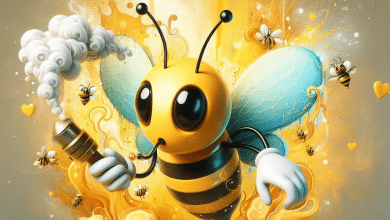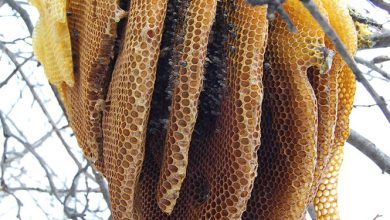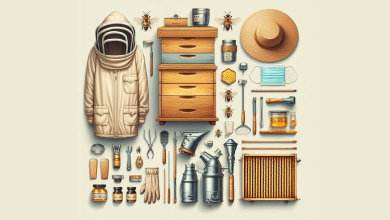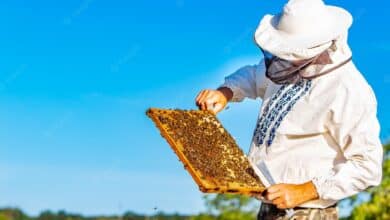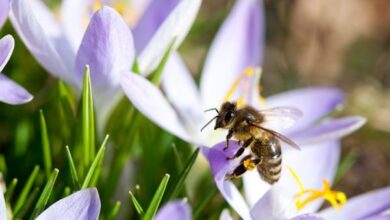The Importance of Quality Beekeeping Equipment for Hive Health

Using high-quality beekeeping equipment offers numerous advantages. The primary benefit is improved bee health. Premium hive components ensure better insulation and ventilation, creating a comfortable environment for bees. This can increase the overall well-being and productivity of the colony.
Durability is another significant advantage. High-quality equipment withstands the wear and tear of regular use, lasting longer than cheaper alternatives. This durability saves beekeepers money in the long run.
Safety is also a key consideration. Beekeeping can be hazardous if not done properly. Top-notch equipment, including protective gear, provides superior protection against bee stings and other risks, ensuring that beekeepers remain safe while working.
Efficiency is greatly enhanced with quality tools. Well-designed equipment is easier to use and more effective at getting the job done. This means that beekeepers can manage their hives more efficiently, saving time and effort.
Overall, investing in quality equipment contributes to healthier bees, safer working conditions, and more efficient hive management. The long-term benefits make it a worthwhile investment for any serious beekeeper.
Benefits of using high-quality equipment for beekeeping
Beekeepers who invest in high-quality equipment often see improved hive health. Premium materials ensure better insulation, crucial for maintaining optimal temperatures. This helps to protect the bees from extreme weather conditions. Robust construction also means the hives last longer and demand less frequent replacements, saving costs over time.
Quality equipment simplifies hive management. Tools and accessories designed with precision make routine tasks easier and more efficient. This includes tasks such as inspecting the hive, harvesting honey, and performing maintenance work.
Safety is another significant benefit. High-quality protective gear reduces the risk of bee stings. It offers better coverage and comfort, allowing beekeepers to work more confidently around the hive.
Ventilation is another area where quality matters. Properly designed hives provide adequate airflow, reducing moisture buildup. This is vital for preventing mold and other issues that can compromise bee health.
In summary, investing in high-quality beekeeping equipment contributes to better bee health, improved efficiency, and enhanced safety for beekeepers. These long-term benefits make it a worthwhile consideration for anyone serious about successful beekeeping.
Impact of quality equipment on hive health
High-quality equipment can significantly impact hive health. Durable materials provide better insulation, essential for maintaining stable temperatures inside the hive. This stability is particularly important during extreme weather conditions, protecting bees from both heat and cold.
Properly designed equipment enhances ventilation within the hive, reducing moisture buildup. Excessive moisture can lead to mold and other issues detrimental to bee health. By ensuring optimal airflow, top-tier equipment supports a healthier living environment for the bees.
Quality feeding systems also play a crucial role. Reliable feeders are easier for bees to access, ensuring they receive the necessary sustenance during lean periods. This constant food supply can prevent colony stress and improve overall resilience.
Additionally, well-constructed hives are easier to inspect and maintain. Simplified inspections allow beekeepers to detect and address issues such as disease or pests early on. Swift action in these areas can prevent minor problems from escalating into major threats to hive health.
In summary, the investment in high-quality equipment fosters a stronger, healthier bee colony. By providing better insulation, ventilation, and ease of maintenance, quality gear ensures the hive remains a conducive environment for bee productivity and longevity.

Hive Components for Optimal Bee Health
High-quality hive components play a crucial role in maintaining bee health. Each part of the hive contributes to the overall well-being of the bees. For instance, durable frames ensure a stable structure for the bees to build their combs on. High-grade wood or plastic frames are more resistant to weather and pests. This longevity reduces the frequency of replacements, minimizing disruption for the colony.
Well-insulated hive boxes help regulate internal temperatures. In areas with distinct seasonal changes, like Houston, maintaining a consistent temperature inside the hive is essential. Insulated boxes protect the colony from extreme heat and frigid temperatures, promoting year-round activity and productivity.
Additionally, high-quality foundation sheets provide a reliable base for honeycomb construction. These sheets guide bees in building straighter and stronger combs, reducing the risk of collapse and making inspections easier for beekeepers.
Pest-resistant entrance reducers are also vital. They help control the traffic of bees while keeping out pests like mites and beetles. This feature is particularly important for preventing disease spread within the hive.
In sum, investing in top-tier hive components supports better bee health, productivity, and longevity. Each piece works together to create a robust, efficient environment for the hive.
Essential hive components for maintaining bee health
High-quality hive components are crucial for maintaining bee health. Sturdy frames provide a stable foundation for bees to build their combs. Using durable materials like wood or plastic reduces the need for frequent replacements, minimizing colony disruption.
Well-insulated hive boxes regulate internal temperatures, essential for bees to thrive throughout the year. Consistent temperatures aid in proper brood development and reduce stress on the colony.
Foundation sheets also play a vital role. They guide bees in constructing straight and strong honeycombs, which are less prone to collapse. Strong combs make it easier for beekeepers to inspect and manage the hive without disturbing the bees.
Entrance reducers help control the flow of bees while keeping out pests like mites and beetles. This is critical for preventing disease and maintaining the overall health of the hive.
Air vents in the hive box ensure adequate ventilation, reducing moisture buildup and preventing mold growth. Proper airflow is crucial for a healthy living environment.
Combining these elements creates a harmonious and efficient habitat for bees. Investing in quality hive components leads to better productivity and longevity of the colony.
How quality equipment contributes to bee colony productivity
Quality beekeeping equipment significantly boosts bee colony productivity. High-grade tools facilitate better hive management. Efficient frames and foundation sheets allow bees to build strong, straight combs. This yields higher honey production.
Durable hive boxes protect colonies from harsh weather. Bees expend less energy on temperature regulation and more on foraging and nurturing young bees. Ventilation systems minimize moisture, reducing the risk of mold and disease.
Entrance reducers control hive traffic, preventing pests like mites from entering. This improves colony health and productivity. Bees focus on gathering nectar and pollen instead of defending the hive.
Proper feeding equipment ensures that bees receive essential nutrients. This is especially crucial during nectar dearth periods. Healthy, well-fed bees are more active and productive.
Bee suits and gloves protect beekeepers, reducing the risk of stings. Comfortable beekeepers perform inspections more thoroughly, identifying and addressing issues promptly.
Hive monitoring devices provide real-time data on hive conditions. Early detection of problems allows quick intervention, maintaining colony health and productivity.
Overall, investing in quality equipment leads to fewer disruptions and higher efficiency in hive operations. This directly correlates to an increase in bee colony productivity, ensuring robust and thriving hives.

Protective Gear for Beekeepers
Importance of wearing proper beekeeping protective gear
Beekeeping requires suitable protective gear. Beekeepers face the risk of bee stings without it. Adequate attire minimizes this risk immensely. A bee suit creates a barrier between the bees and the beekeeper’s skin. Gloves offer additional protection. This gear allows beekeepers to handle bees with confidence.
Features to consider when choosing protective clothing and accessories
Quality materials are vital for protective gear. Durable fabrics resist wear and tear. Properly fitted clothing ensures maximum protection while allowing ease of movement. Well-designed veils offer clear visibility, ensuring safety during inspections. Easy-to-clean materials are a practical choice for long-term use.
Beekeepers must balance protection with comfort. High-quality gear prolongs the lifespan of the apparel. Investing in solid protective gear enhances the beekeeping experience. It’s the first step to a safe and fulfilling journey in beekeeping. With appropriate equipment, beekeepers can focus more on hive management and less on personal safety concerns.
These considerations help beekeepers choose their gear wisely. The right equipment supports effective hive management, ultimately contributing to better hive health and productivity.
Importance of wearing proper beekeeping protective gear
Beekeepers face inherent risks when working with honey bees. Protective gear serves as a crucial safety measure. Bee suits, gloves, and veils form a barrier against bee stings. This equipment keeps bee stings to a minimum and enhances the overall experience.
A full bee suit is the best way to protect most of the body. It ensures that bees cannot reach exposed skin. Gloves, while sometimes reducing dexterity, are essential for hand protection. Many new beekeepers benefit from this added layer of safety.
Face protection is vital. Veils shield the face and neck, areas that are particularly sensitive to stings. Experienced beekeepers may wear less gear but always keep their faces covered.
Comfortable and properly fitted gear makes a difference. Ill-fitted suits or gloves can lead to discomfort and distraction. This can impact hive management and safety.
Investing in high-quality protective gear pays off. It prolongs the gear’s lifespan and offers better protection. When beekeepers feel safe, they can focus on learning more about their bees.
New beekeepers, especially, should prioritize full protection. Over time, they may adjust their gear as they gain confidence and skill.
Features to consider when choosing protective clothing and accessories
Beekeepers should prioritize material quality. Look for durable fabrics that offer sting resistance. Cotton and polyester blends are popular choices. Breathability is crucial, especially in warmer climates. Mesh venting can provide additional airflow.
The fit of protective gear matters. A well-fitted bee suit reduces the risk of bees getting inside. Adjustable elastic bands at the wrists and ankles enhance this protection. Thumb loops can help keep sleeves in place when inserting gloves.
Consider the design of zippers and closures. Double-stitched seams and robust zippers minimize the risk of bees entering through gaps. A full-front zipper makes it easier to put on and take off the suit.
Veils must offer clear visibility and ample face protection. Ensure the veil provides a wide field of view. High-quality veils prevent mesh from touching the face, further reducing sting risks.
Gloves are essential for new beekeepers. Leather gloves are durable but can limit dexterity. More flexible materials, like nitrile, offer better movement with some sting protection.
Ease of cleaning is an important factor. Machine washable suits save time and maintain hygiene. Beekeepers should also look for gear with replaceable components for prolonged use.
These features collectively ensure safety and comfort, enhancing the beekeeping experience.

Tools and Accessories for Hive Management
Beekeeping demands a variety of tools and accessories for effective hive management. Essential items include smokers, hive tools, and feeders. Smokers help calm the bees, making inspections smoother. Hive tools are crucial for opening hives and scraping off excess wax and propolis.
Feeders ensure bees have access to food when natural sources are scarce. Quality feeders are easy to fill and reduce the risk of drowning bees. Bee brushes enable gentle removal of bees from frames during inspections without harming them.
Varroa mite treatments are vital for maintaining colony health. These mites can significantly impact bee populations if left unchecked. Proper treatment methods and products help mitigate this threat.
Frame grips make handling frames easier, reducing stress on both the beekeeper and the bees. Queen excluders help manage the hive by keeping the queen confined to certain sections, aiding in effective brood rearing.
Each tool enhances efficiency, promoting a healthier and more productive hive. Investing in these quality items significantly improves beekeeping practices, leading to better hive management and overall bee health. Their role in facilitating smooth operations cannot be overstated.
Essential tools and accessories for effective hive management
Beekeepers rely on a variety of tools for effective hive management. Smokers are vital. They calm the bees and make hive inspections smoother. Hive tools assist in opening hives and removing wax and propolis. Feeders provide nourishment during scarce food periods.
Bee brushes remove bees gently from frames without harm. They are essential during inspections and honey harvests. Varroa mite treatments protect colonies from destructive pests. Effective treatments are crucial for maintaining bee health.
Frame grips make handling frames easier and less stressful for both bees and beekeepers. Queen excluders help manage hive sections by confining the queen to specific areas. This aids in efficient brood rearing.
Each tool serves a unique purpose, enhancing the efficiency of hive tasks. Proper equipment ensures smoother operations and a healthier bee colony. Investing in these quality tools is essential for successful beekeeping.
These items collectively promote better hive management and bee health. They support the beekeeper’s efforts to maintain productive hives. Their roles in facilitating daily tasks cannot be overstated, making them indispensable in beekeeping practices.
How quality equipment improves beekeeping efficiency
Quality equipment enhances beekeeping efficiency in numerous ways. It is designed to be user-friendly, reducing the time and effort needed for routine tasks. Durable materials ensure longer-lasting tools, meaning fewer replacements and interruptions. Efficiently crafted hive tools allow beekeepers to manage hives with precision.
High-quality smokers produce consistent smoke, calming bees quickly and making inspections smoother. Feeders made from superior materials ensure bees receive steady nourishment without frequent refills. This consistency promotes better hive health and reduces the beekeeper’s workload.
Properly designed hive components provide better insulation and ventilation. This creates a stable environment that minimizes the bees’ stress, leading to a more productive colony. Well-ventilated hives are easier to maintain and inspect, promoting regular monitoring.
Advanced hive monitoring devices offer real-time data on hive conditions. Beekeepers can swiftly address issues, preventing small problems from escalating. These devices streamline the monitoring process and contribute to proactive hive management.
In summary, investing in top-notch beekeeping supplies not only safeguards bee health but also streamlines operations. Efficient tools and durable equipment enable beekeepers to maintain their hives effectively while minimizing effort and maximizing productivity. This leads to healthier colonies and a more rewarding beekeeping experience.

Hive Monitoring Devices
Benefits of using hive monitoring devices for bee health
Hive monitoring devices provide real-time data on various hive conditions. These gadgets track temperature, humidity, and hive weight. By offering insights into these metrics, they help prevent issues before they escalate. Early detection of problems such as mite infestation or queen failure is possible. Timely interventions can then be made to sustain hive health.
Features of quality monitoring equipment for beekeepers
Quality monitoring devices have several notable features. They are often durable and weather-resistant, ensuring long-term use. Accuracy is crucial; top-tier models provide precise data. User-friendly interfaces make it easy to interpret the collected information. Some devices also offer remote access, allowing beekeepers to monitor hives without being physically present.
These tools often integrate with smartphones or computers, enabling quick data analysis. Alerts and notifications can be set for critical thresholds, prompting immediate action when necessary. Investing in reliable monitoring equipment ensures continuity in hive management and promotes a proactive approach to maintaining bee health.
In conclusion, hive monitoring devices are invaluable for ensuring colonies thrive. They simplify the task of keeping tabs on hive conditions, leading to healthier and more productive bees.
Benefits of using hive monitoring devices for bee health
Hive monitoring devices are vital for early detection of hive issues. These devices measure critical factors such as temperature, humidity, and hive weight. By monitoring these parameters, beekeepers can identify problems before they become severe.
These devices provide real-time data, which helps in maintaining optimal conditions inside the hive. For instance, maintaining a steady temperature is crucial for the development of brood and overall bee health. By receiving alerts on potential temperature drops or spikes, beekeepers can take immediate action.
Humidity control is another significant benefit. Excessive moisture can lead to mold and other issues, while too little can affect brood development. Monitoring devices help strike the right balance, ensuring a healthy hive environment.
Hive weight monitoring aids in tracking honey production and food stores. Sudden weight loss may indicate swarming or other issues requiring attention. Continuous data collection allows for better planning and management of feeding schedules and honey harvests.
The use of these devices also reduces the need for frequent physical inspections, minimizing hive disturbances. Overall, hive monitoring devices contribute significantly to healthier, more productive bee colonies by enabling proactive and informed hive management.
Features of quality monitoring equipment for beekeepers
Quality monitoring equipment for beekeepers offers several key features. First, it provides real-time data, allowing beekeepers to monitor hive conditions continuously. This is essential for making prompt decisions to ensure hive health. High-quality devices come with reliable sensors that measure critical parameters like temperature, humidity, and hive weight. These sensors are often designed to withstand harsh weather conditions, ensuring longevity and consistent performance.
Another important feature is ease of installation and use. Good monitoring equipment should be user-friendly, allowing even beginners to set up and understand the data without difficulty. Many devices also offer wireless capabilities, enabling remote monitoring through smartphones or computers. This allows beekeepers to keep an eye on their hives from anywhere.
Battery life is another crucial aspect. Quality equipment comes with long-lasting batteries or even solar charging options, reducing the need for frequent maintenance. Data storage and analytics are also vital; these devices typically come with cloud storage options that store historical data for trend analysis.
Overall, these features make monitoring equipment indispensable for effective and efficient hive management. They help ensure healthier bee colonies and more productive hives by providing timely and accurate data.

Investing in quality beekeeping equipment is vital. It ensures hives remain healthy and productive. High-quality supplies help beekeepers manage their colonies more effectively. They reduce the risk of disease and improve hive performance.
Proper gear protects both bees and beekeepers. Durable and reliable tools make daily tasks easier. Monitoring devices, for instance, provide critical data about hive conditions. This enables prompt actions to address any issues. Ensuring optimal hive health leads to better honey production and stronger colonies.
Choosing the right equipment requires careful consideration. Beekeepers should prioritize materials that are robust and weather-resistant. Long-lasting batteries and easy-to-read interfaces are also essential features. Reviewing customer feedback can offer insights into the reliability of products.
Beginners can benefit from starter kits tailored to their needs. Experienced beekeepers might invest in specialized tools for advanced hive management. Regardless of experience level, quality equipment saves time and resources in the long run.
In summary, quality equipment is a cornerstone of successful beekeeping. It enhances hive maintenance and supports colony well-being. Beekeepers should seek out reputable suppliers to ensure they get the best tools for the job. This approach not only benefits bee colonies but also makes beekeeping a more rewarding endeavor.
The significance of investing in quality beekeeping equipment
Investing in quality beekeeping equipment makes a notable difference. High-end tools ensure durability, lasting longer and saving money over time. They withstand the demands of regular beekeeping activities, providing reliable performance season after season.
Safety is another critical factor. Top-notch gear offers superior protection against bee stings and other potential hazards. Well-made protective clothing and accessories, like gloves and bee suits, keep beekeepers safe and comfortable.
Efficiency is greatly enhanced with quality tools. Ease of use is a hallmark of well-crafted equipment. Simple yet effective designs make daily tasks quicker and less cumbersome. Whether it’s a smoker, hive tool, or frame gripper, good equipment streamlines the beekeeping process.
A healthy hive is the direct result of using dependable gear. Robust hive components reduce the risk of disease and infestation. Consistent and accurate monitoring devices help maintain optimal conditions within the hive.
Overall, quality equipment contributes significantly to the success of beekeeping endeavors. It enhances both productivity and enjoyment. By prioritizing reliable gear, beekeepers set themselves up for long-term success and healthier bee colonies.
Tips for selecting the best equipment for maintaining hive health
When selecting beekeeping equipment, focus on quality first. Reputable brands often deliver durable products. Check for materials that resist wear and tear. Stainless steel and hardy plastics are good choices. Reading product reviews helps gauge reliability.
Suitability for the local environment matters. Choose equipment designed for specific climates. In warmer areas like Houston, ventilation features in hives are crucial. Insulated hives work well in colder regions.
Seek advice from experienced beekeepers. Their insights can guide better decisions. Attend local beekeeping workshops if available. These events offer firsthand demonstrations of equipment.
Ease of use is also essential. Look for ergonomic designs that simplify tasks. Lightweight tools reduce fatigue during inspections. Products with clear instructions aid quicker setups and use.
Consider the space available for your beekeeping activities. Compact tools and foldable gear save storage space. Modular hive components allow easy expansion as the colony grows.
Lastly, factor in safety features. High-quality protective gear reduces sting risks. Well-ventilated bee suits keep beekeepers cool while protecting against stings.
In summary, prioritize quality, functionality, and comfort when choosing beekeeping equipment to maintain hive health effectively.
What should I look for in a healthy hive?
When evaluating a hive’s health, look for active bee movement. Bees should be buzzing in and out, collecting pollen and nectar. A healthy hive has a consistent, pleasant hum, not a distressed or silent tone.
Check for clean, evenly capped brood cells. These indicate good queen activity and proper colony development. Spot the queen regularly; she should be laying eggs actively. The presence of eggs, larvae, and sealed brood in various stages shows a thriving colony.
Assess the honey and pollen stores. A healthy hive will have sufficient food reserves, especially heading into colder months. Quality honey frames are crucial for sustenance.
Monitor the hive’s entrance and interior for signs of pests or disease. Look for mites, beetles, or foul odors. Effective pest control is integral for a healthy hive.
Inspect the bees themselves. They should look robust and free from deformities or mites. Healthy bees will exhibit vibrant colors and active behavior.
Observe the hive’s population. A strong, populous colony is essential for effective pollination and honey production.
Lastly, ensure good ventilation and temperature control inside the hive. Proper air flow helps prevent moisture buildup and disease. Quality hive components aid in maintaining optimal internal conditions.
How do you keep a hive healthy?
Beekeepers must take several steps to maintain hive health. First, they monitor for pests and diseases regularly. Common threats like Varroa mites and foulbrood can devastate a colony if left unchecked. Colonies should be inspected every few weeks.
Second, providing clean and well-maintained equipment is essential. Tools should be sanitized to prevent contamination. Bees are highly susceptible to infections from bacteria and fungi. Regular cleaning can avert detrimental situations.
Third, adequate food stores must be ensured. Bees need a constant supply of nectar and pollen. Providing supplemental feeding can help during times of shortage. Sugar water or pollen patties are common supplements.
Fourth, good ventilation is crucial. Proper airflow helps reduce moisture buildup, which can cause mold and diseases. Beekeepers should ensure hive entrances are clear and not obstructed.
Finally, hive placement matters. Hives should be located in areas with plenty of sunlight and protection from strong winds. This helps maintain a stable internal temperature, vital for bee health.
Beekeeping involves attention to detail and proactive measures. By following these practices, beekeepers can ensure their colonies remain robust and productive.
What is the most important part of a beehive?
The frame stands out as the most important part of a beehive. It fits neatly inside the hive’s supers, providing a structure for the bees to build their comb. This comb is crucial. Within it, the queen lays her eggs, and young bees develop. The comb also serves as a storage space for honey and pollen, which are essential for the colony’s survival.
Frames help keep the hive organized. Bees rely on this structure to carry out their daily activities effectively. Without a sturdy frame, the hive could become chaotic, leading to lower productivity and higher stress among the bees.
Another vital aspect is cleanliness. High-quality frames are easier to inspect and maintain. Regular checks can prevent diseases and pests from spreading within the hive. Beekeepers should prioritize durable materials to ensure longevity and stability.
In regions with heavy rainfall, keeping the hive off wet ground is imperative. Hive stands can provide this necessary elevation, ensuring dryness and stability. By focusing on these essential components, beekeepers can maintain a healthy and productive colony.
What does a bee keeper need?
A beekeeper needs several essential items to manage a beehive successfully. First, they require a properly constructed hive. This includes hive bodies, frames, and foundation sheets where bees build their comb.
Protective clothing is crucial. A beekeeper’s suit, gloves, and a veil help prevent stings and keep the beekeeper safe. Additionally, a smoker is indispensable. It calms the bees, making it easier to inspect the hive without causing distress.
Tools for hive management are necessary too. A hive tool helps in prying apart boxes, scraping out propolis, and removing frames. A bee brush gently moves bees off combs during inspections without harming them.
Feeding equipment comes in handy during times of scarcity. Feeders can provide sugar syrup or pollen substitutes to support the colony.
Hive monitoring devices also play a role. These gadgets can track temperature, humidity, and hive activity, giving insights into the colony’s health.
Lastly, a beekeeper must have good knowledge and continued learning. Resources like books, online courses, and local beekeeping associations offer valuable information for ongoing education.
With these essentials, beekeepers can maintain healthy and productive hives.
And there you have it. Quality beekeeping equipment isn’t just a luxury—it’s a necessity for the health and sustainability of your hives, especially here in Houston. Whether you’re a hobbyist or a professional, investing in top-notch supplies ensures your bees thrive, contributing to our local ecosystem and agricultural success. We’d love to hear your experiences and tips on maintaining hive health. What equipment do you find essential for successful beekeeping? Let’s keep the conversation buzzing!



